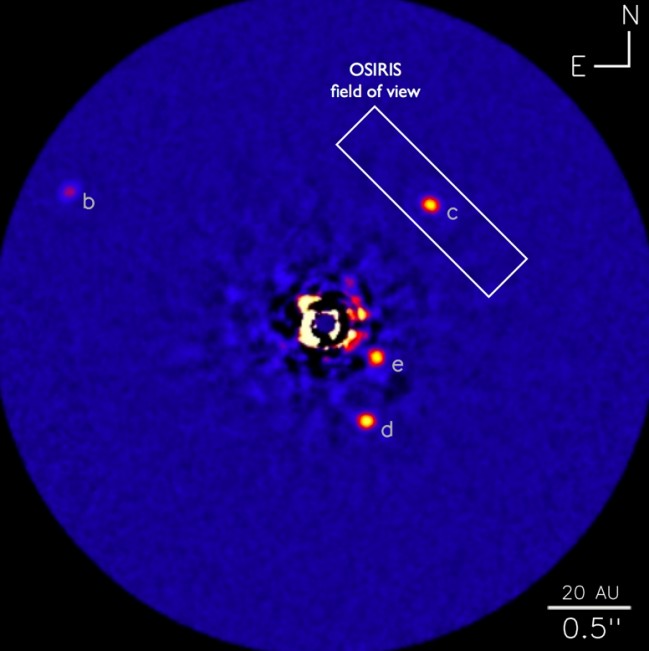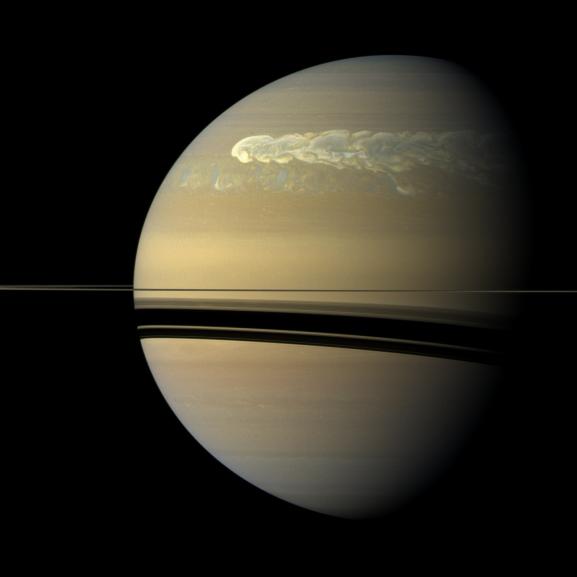
It wasn’t too long ago that astronomers found the first indirect evidence of a planet beyond our solar system. They inferred the presence of an exoplanet (extrasolar planet) from the periodic dimming or wiggle of its parental star, rather than much more difficult direct observation. Since the first confirmed exoplanet was discovered in 1995 (51 Pegasi b), researchers have definitively catalogued around 800, and identified another 18,000 candidates. And, the list seems to now grow daily.
If that wasn’t amazing enough researchers now have directly observed several exoplanets and even measured their atmospheric composition.
[div class=attrib]From ars technica:[end-div]
The star system HR 8799 is a sort of Solar System on steroids: a beefier star, four possible planets that are much bigger than Jupiter, and signs of asteroids and cometary bodies, all spread over a bigger region. Additionally, the whole system is younger and hotter, making it one of only a few cases where astronomers can image the planets themselves. However, HR 8799 is very different from our Solar System, as astronomers are realizing thanks to two detailed studies released this week.
The first study was an overview of the four exoplanet candidates, covered by John Timmer. The second set of observations focused on one of the four planet candidates, HR 8799c. Quinn Konopacky, Travis Barman, Bruce Macintosh, and Christian Marois performed a detailed spectral analysis of the atmosphere of the possible exoplanet. They compared their findings to the known properties of a brown dwarf and concluded that they don’t match—it is indeed a young planet. Chemical differences between HR 8799c and its host star led the researchers to conclude the system likely formed in the same way the Solar System did.
The HR 8799 system was one of the first where direct imaging of the exoplanets was possible; in most cases, the evidence for a planet’s presence is indirect. (See the Ars overview of exoplanet science for more.) This serendipity is possible for two major reasons: the system is very young, and the planet candidates orbit far from their host star.
The young age means the bodies orbiting the system still retain heat from their formation and so are glowing in the infrared; older planets emit much less light. That makes it possible to image these planets at these wavelengths. (We mostly image planets in the Solar System using reflected sunlight, but that’s not a viable detection strategy at these distances). A large planet-star separation means that the star’s light doesn’t overwhelm the planets’ warm glow. Astronomers are also assisted by HR 8799’s relative closeness to us—it’s only about 130 light-years away.
However, the brightness of the exoplanet candidates also obscures their identity. They are all much larger than Jupiter—each is more than 5 times Jupiter’s mass, and the largest could be 35 times greater. That, combined with their large infrared emission, could mean that they are not planets but brown dwarfs: star-like objects with insufficient mass to engage in hydrogen fusion. Since brown dwarfs can overlap in size and mass with the largest planets, we haven’t been certain that the objects observed in the HR 8799 system are planets.
For this reason, the two recent studies aimed at measuring the chemistry of these bodies using their spectral emissions. The Palomar study described yesterday provided a broad, big-picture view of the whole HR 8799 system. By contrast, the second study used one of the 10-meter Keck telescopes for a focused, in-depth view of one object: HR 8799c, the second-farthest out of the four.
The researchers measured relatively high levels of carbon monoxide (CO) and water (H2O, just in case you forgot the formula), which were present at levels well above the abundance measured in the spectrum of the host star. According to the researchers, this difference in chemical composition indicated that the planet likely formed via “core accretion”— the gradual, bottom-up accumulation of materials to make a planet—rather than a top-down fragmentation of the disk surrounding the newborn star. The original disk in this scenario would have contained a lot of ice fragments, which merged to make a world relatively high in water content.
In many respects, HR 8799c seemed to have properties between brown dwarfs and other exoplanets, but the chemical and gravitational analyses pushed the object more toward the planet side. In particular, the size and chemistry of HR 8799c placed its surface gravity lower than expected for a brown dwarf, especially when considered with the estimated age of the star system. While this analysis says nothing about whether the other bodies in the system are planets, it does provide further hints about the way the system formed.
One final surprise was the lack of methane (CH4) in HR 8799c’s atmosphere. Methane is a chemical component present in all the Jupiter-like planets in our Solar System. The authors argued that this could be due to vigorous mixing of the atmosphere, which is expected because the exoplanet has higher temperatures and pressures than seen on Jupiter or Neptune. This mixing could enable reactions that limit methane formation. Since the HR 8799 system is much younger than the Solar System—roughly 30 million years compared with 4.5 billion years—it’s uncertain how much this chemical balance may change over time.
[div class=attrib]Read the entire article after the jump.[end-div]
[div class=attrib]One of the discovery images of the system obtained at the Keck II telescope using the adaptive optics system and NIRC2 Near-Infrared Imager. The rectangle indicates the field-of-view of the OSIRIS instrument for planet C. Courtesy of NRC-HIA, C. Marois and Keck Observatory.[end-div]



